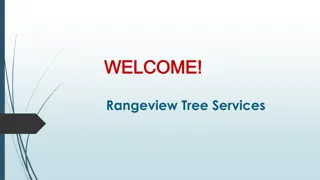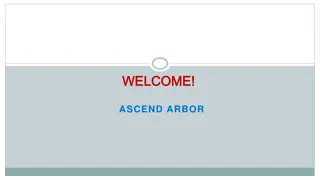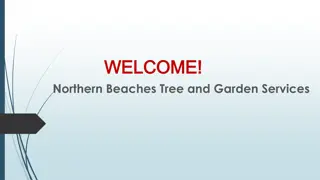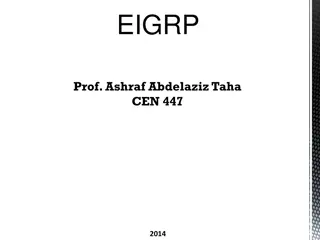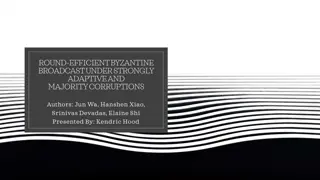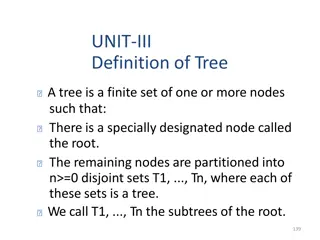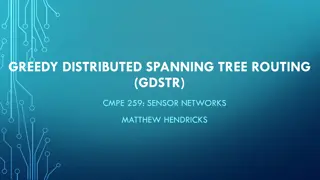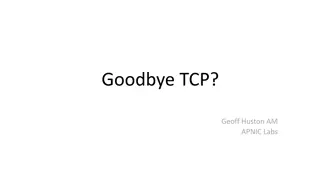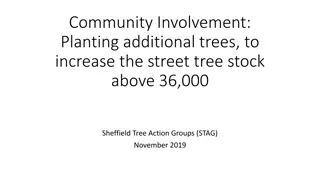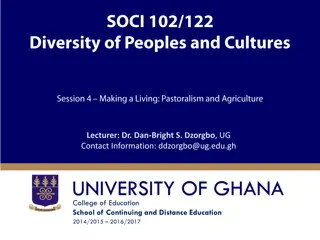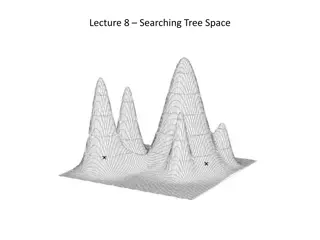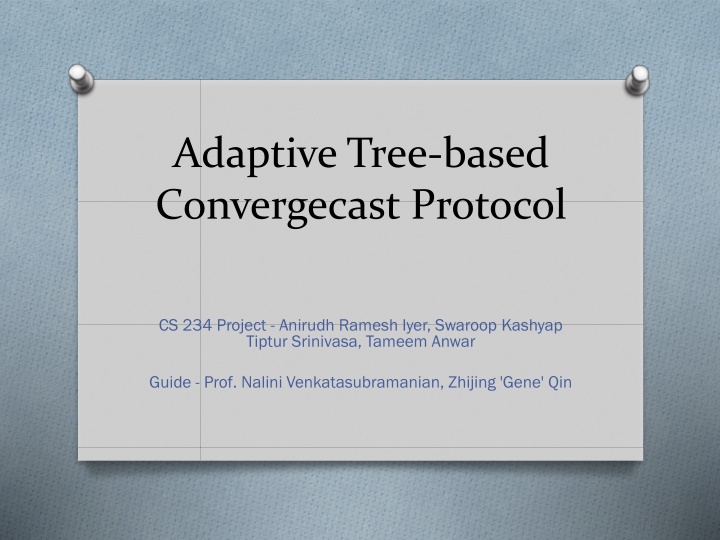
Adaptive Tree-based Convergecast Protocol
Adaptive tree-based protocol for managing overlay networks in heterogeneous networks. It proposes improvements to the existing Tree-Based Convergecast Routing (TBCR) protocol by considering additional parameters such as RTT, power consumption, link stability, and link mobility to optimize routing decisions. The protocol uses a set of rules and actions to achieve energy efficiency, load balancing, and improved link utilization. The project also presents challenges in system interaction and modifications to existing data structures and message formats.
Download Presentation

Please find below an Image/Link to download the presentation.
The content on the website is provided AS IS for your information and personal use only. It may not be sold, licensed, or shared on other websites without obtaining consent from the author. If you encounter any issues during the download, it is possible that the publisher has removed the file from their server.
You are allowed to download the files provided on this website for personal or commercial use, subject to the condition that they are used lawfully. All files are the property of their respective owners.
The content on the website is provided AS IS for your information and personal use only. It may not be sold, licensed, or shared on other websites without obtaining consent from the author.
E N D
Presentation Transcript
Adaptive Tree-based Convergecast Protocol CS 234 Project - Anirudh Ramesh Iyer, Swaroop Kashyap Tiptur Srinivasa, Tameem Anwar Guide - Prof. Nalini Venkatasubramanian, Zhijing 'Gene' Qin
Introduction Characteristics of heterogeneous networks O Mobility - Stationary devices, Mobile device O Medium - Ethernet, WiFi, Bluetooth, Zigbee O Computing Power - Servers, Desktops, Laptops, Smartphones, Motes Problems in heterogeneous networks O Any distributed application needs its peers/nodes to talk to each other independent (heterogeneous) network. O The solution to this problem is construction of overlay network and its management. of underlying
Related Work O BCP, CTP are schemes used in Wireless Sensor Networks. O Tree-Based Convergecast Routing protocol is used for overlay management in heterogeneous networks. O TBCR protocol is efficient and robust in terms of its control plane functions and control data exchange. construction and
Recommended Improvements in TBCR - Adaptive TBCR O Though TBCR protocol is efficient, it bases it's decision on hop-count as delay metric decision-making process is local to nodes. O We propose to extend the decision-making process by including parameters - RTT, Power consumption, Link mobility, Link medium and Link stability. O This information is collected locally at every node and pushed to the server which optimizes the current routing decision taken by TBCR. and saturation, Predictive
Adaptive TBCR O Pure localized decisions may not be optimal decisions as any decision taken does not consider information available more than one hop away from a node. Ex: Vanilla TBCR uses hop-count as delay and prefers one-hop path to a two-hop path which is not always optimal when one-hop path is saturated or signal strength (WiFi) is weak. O In Adaptive TBCR we define rules and actions which (selectively) overrides the decision taken by TBCR protocol.
Adaptive TBCR Design - Protocol Metrics The set of rules/actions are based on certain parameters which are defined as follows: Enable ATBCR flag, A = 0 or 1. If yes then rest follows else discard. Node Stability S = 1 1/(uptime + 1) varies from 0 (worst) to 1 (best). Link stability is measured using period of time a pair of nodes have been connected with each other. Link Utilization Ratio (LUR) = (Link Utilized)/(Link Capacity) Delay D = RTT + Jitter. RTT, Jitter are plain ping and standard deviation in ping time, in our case it can be parent alive message and response to it. Energy Efficiency E = (Combination of Data Transmitted & Power Consumed). Bluetooth has data rate 1mbps, WiFi has data rate of 11-40mbps, Ethernet has dat rate of 10-100mbps(maybe Gs also). We define it as average power consumption per KB sent/received . Link Medium N = Ethernet(1), WiFi(2), Bluetooth(3). Mobility M = Velocity of a node (magnitude is generations hopped and direction is with respect to stationary nodes act as quadrants in the tree). 1. 2. 3. 4. 5. 6. 7.
Adaptive TBCR Design - Protocol Rules/Actions The rules/actions are defined, in order of their priority, as follows: Energy efficient path. Compute energy efficiency of paths by checking power-drain rate of every path and switching to least power-drain path. Configurable ping message interval so that more stable links need not frequently check it out. This rule uses definitions 6, 2, 3 to minimize LUR due to control plane messages. Delay unit. Change delay metric to use RTT+4*Jitter from hopcount. This rule uses definition 4. Weighted Tree balancing (Load balancing). This rule balances the tree based on Link Utilization and uses definitions 3 and 2 (prefers more stable and high capacity links). LUR% change with time. This rules uses definition 3 to judge switching to a path which has stable capacity for applications which demand higher capacity. Best Parent prediction. This rule is based on mobility of child node, uses definition 7 and 6 to predict where a node will be at a certain point in time. Radically Different Topology. Change hierarchy from tree to cone like having a virtual ring(maybe partial) at every generation level. If higher link from generation i to i 1 is choking/choked then we try to load-balance using path (i, j) to (i, j+1) (basically a neighbor) then (i, j+1) to (i 1) (to generation i parent). This rule uses LUR, definitions 1 & 3. 1. 2. 3. 4. 5. 6. 7. Rules 6 and 7 are currently not being considered for ATBCR prototype.
Adaptive TBCR Component Diagram
Adaptive TBCR Implementation Data Structures: IPv4 Neighbors List Path List <Path, Power Drain, LUR, Delay, Stability> 1. 2. Messages: Polled Data PDU Path Change Request PDU Path Change Accept PDU 1. 2. 3.
Adaptive TBCR Challenges O Handling System interaction between existing TBCR system and the proposed Adaptive TBCR solution. O Modification of existing TBCR data structures along with tweaking existing message formats. O Optimal number of message exchanges and reduction in PDU length using aggrgation to reduce message overhead in Adaptive TBCR. O Time!! Design and implementation of new protocol is a huge task.
Adaptive TBCR - Status/ Future Work O Currently building a prototype. O Data collection component is complete for rules 1, 2 ,3, 4 & 5 O Working on transport component & decision-engine. O Transport component demands PDU for polled data, path change request, path change response and aggregation function for polled data. O In decision-engine we plan to write an xml based rules-engine which can be fed as an input with priorities per application type to allow network operator to customize ATBCR. O Also we plan to evaluate ATBCR v/s TBCR on a simulator (qualnet).




